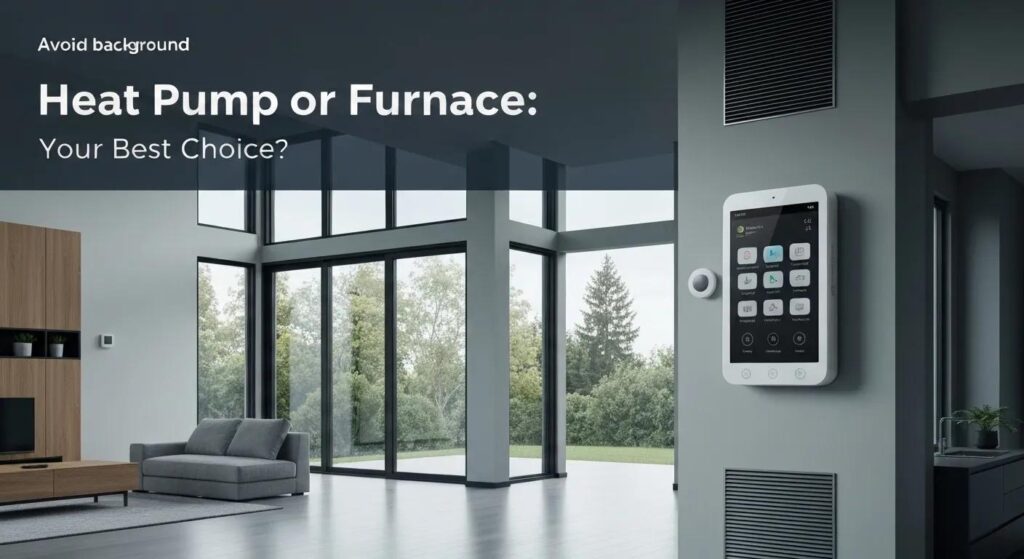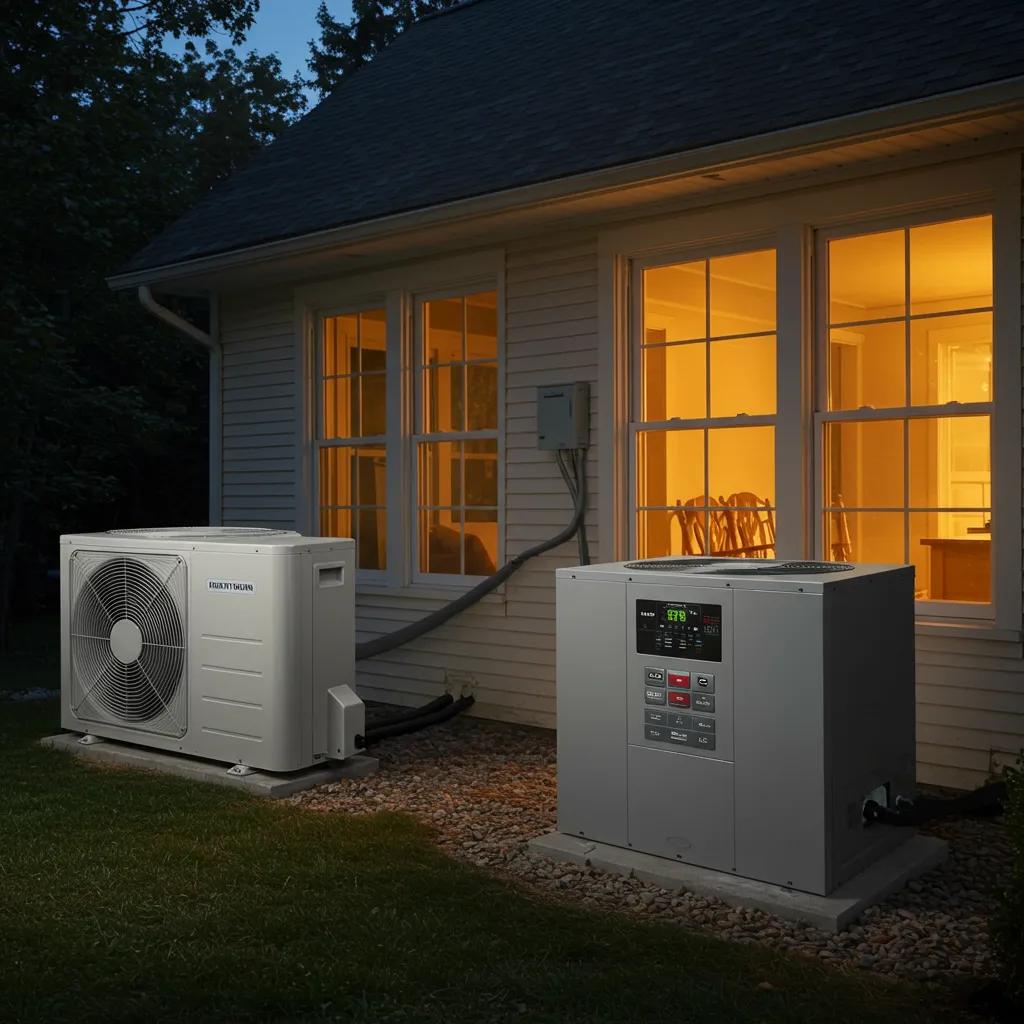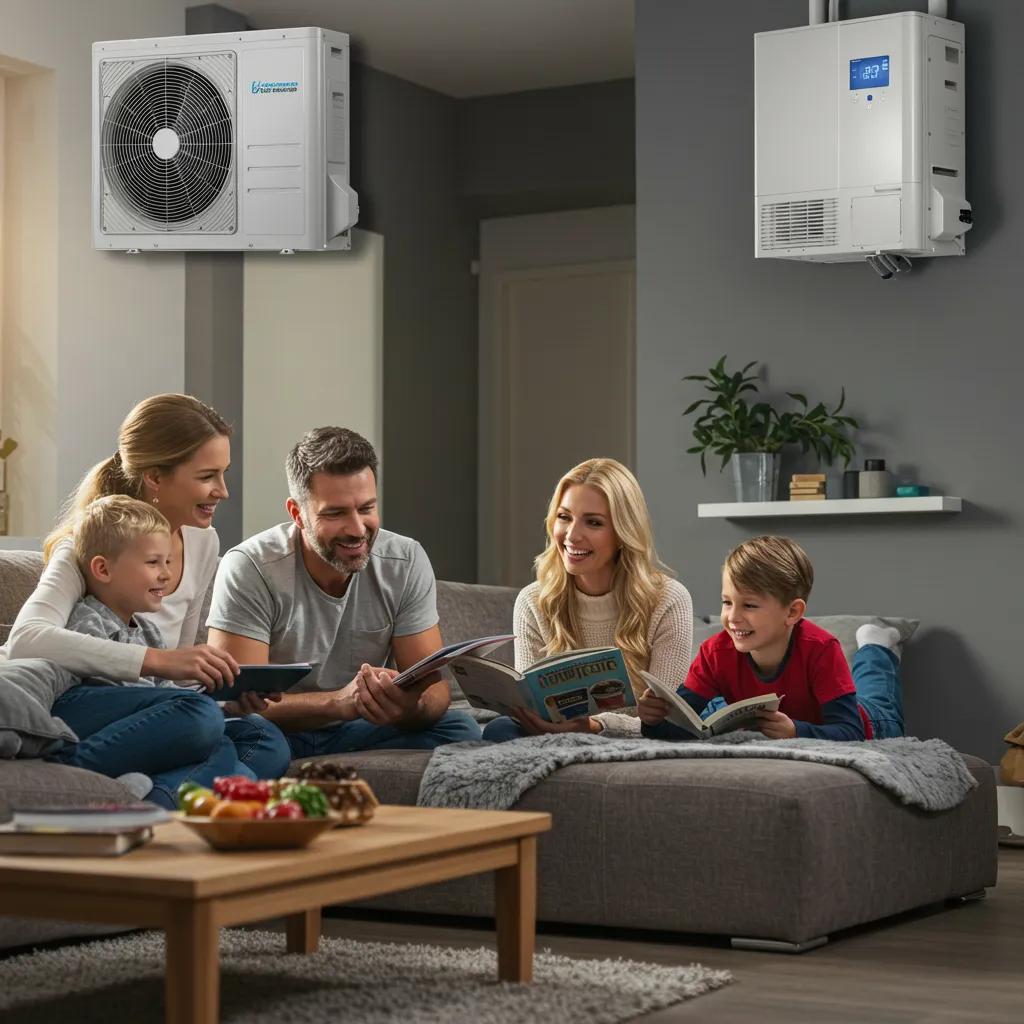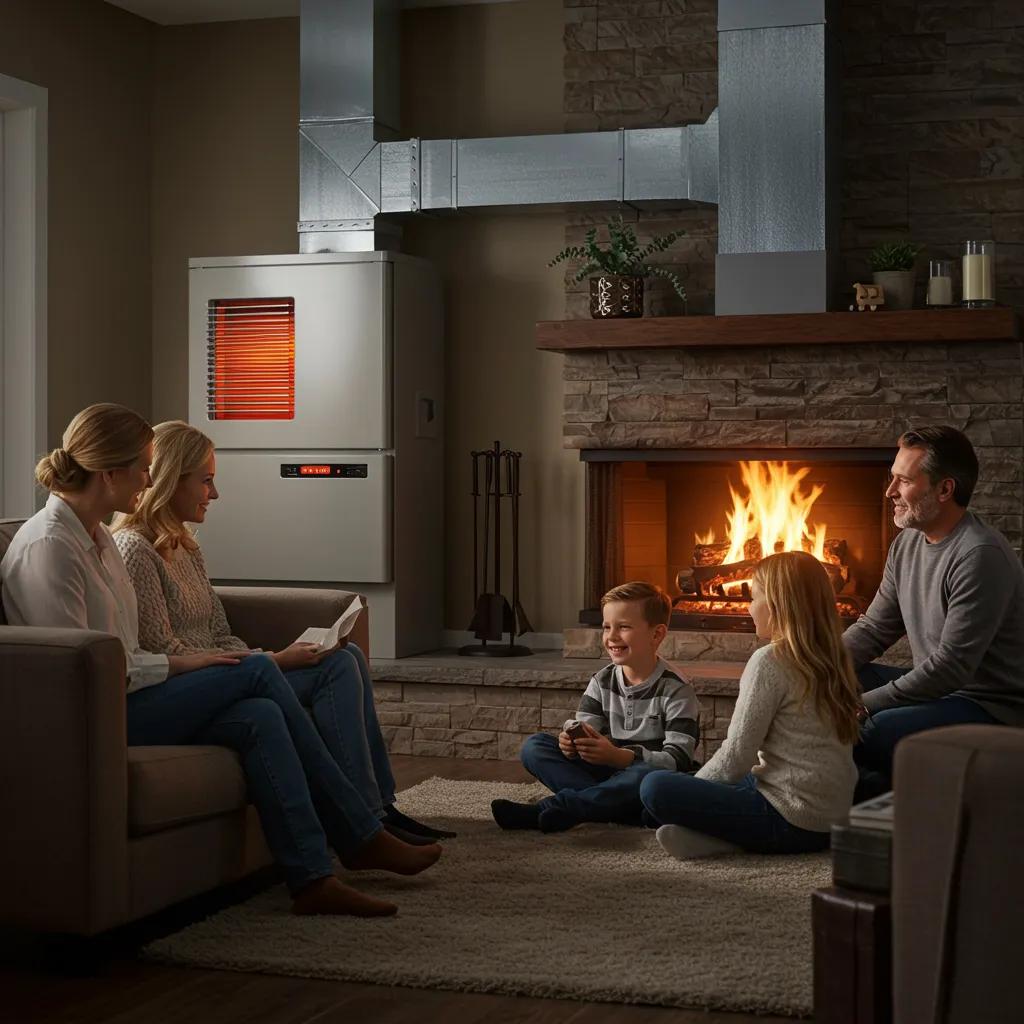
Heat Pump or Furnace: Which is Your Best Bet?

Deciding between a heat pump and a furnace can make all the difference in your year-round comfort and energy bills right here in the Hudson Valley. A heat pump works by moving heat around to warm or cool your home, while a furnace creates heat by burning fuel. This guide will break down how each system operates, compare their installation and running costs, look at how they handle our chilly winters, and cover what kind of maintenance they need. You’ll discover which technology is the perfect fit for your home’s heating needs, our local climate, and your eco-friendly goals—plus, you’ll learn how McCourt Heating & Cooling’s local expertise can help you make the right choice and ensure a flawless installation or repair.
What Exactly Is a Heat Pump and How Does It Work?
A heat pump is an electric system that heats and cools by transferring thermal energy, rather than generating it through burning fuel. The outdoor unit contains a compressor that circulates refrigerant. This refrigerant absorbs heat from the outside air, the ground, or water and then releases it inside your home. In the summer, the process reverses to cool your interiors. This method is incredibly energy-efficient, often delivering three to five times more heat than the electricity it consumes. For Hudson Valley homeowners looking for a single solution for both heating and cooling, a heat pump offers year-round climate control with a smaller carbon footprint. Understanding the different types of heat pumps will help you choose the best one for your home’s size, energy objectives, and climate resilience.
What Are the Different Kinds of Heat Pumps?
- Air-source heat pump systems pull warmth directly from the outside air, adjusting as the seasons change.
- Ground-source (geothermal) heat pumps tap into the consistent temperatures found underground using buried loops to operate more efficiently.
- Water-source heat pumps draw heat from nearby lakes, wells, or ponds, providing reliable performance where water is accessible.
Each of these options is suited for different property setups and budgets, guiding you toward the next step: comparing their advantages against what our local climate demands.
What Are the Main Perks of Heat Pumps?

More and more homeowners and property managers are choosing heat pumps because of these advantages:
- Super Energy Efficient — With Coefficients of Performance (COP) typically between 2.5 and 5.0, they can significantly lower your utility bills.
- Heats and Cools — One system takes care of both your heating and air conditioning needs, replacing separate units.
- Better for the Environment — Running on electricity means less reliance on fossil fuels and a reduced carbon footprint.
These benefits set the stage for comparing their costs against traditional furnaces.
What Are the Downsides of Heat Pumps?
While heat pumps are becoming very popular, there are a couple of things to keep in mind: heat pump services
- Higher Initial Cost — Installation can be quite an investment, especially for geothermal systems, often costing in the mid to high thousands.
- Performance in the Cold — Their efficiency drops when temperatures go below 23°F (-5°C), meaning you might need an extra heat source during the coldest snaps.
Weighing these points will help you compare heat pumps directly with furnaces in the next section.
What Is a Furnace and How Does It Work?
A furnace is a central heating system that generates warmth by burning fuel—usually natural gas, propane, or oil—or by using electric resistance. Inside the furnace, a burner ignites the fuel, heating the air that then travels through a heat exchanger. A fan then pushes this warmed air through your home’s ductwork. This direct heating method provides powerful, consistent warmth, even when it’s freezing outside. Furnaces are a familiar and trusted choice throughout the Hudson Valley, known for heating up spaces quickly and often having a lower initial installation cost, especially for gas models. Understanding the different types of furnaces and their features will help clarify which system might be the best fit for your building’s layout and your budget.
What Kinds of Furnaces Are Common Around the Hudson Valley?
- Gas furnaces use natural gas to create a lot of heat (BTUs) and often qualify for utility company discounts.
- Electric furnaces use resistance coils to heat the air, which means no combustion but they do use more electricity.
- Oil furnaces burn heating oil and are a good option in areas without natural gas lines, offering dependable heat even if they cost more to run.
What Are the Advantages of Furnace Heating Systems?

Furnaces deliver robust heating performance, along with these benefits:
- Heats Up Fast — Their high heat output warms up your home quickly on cold winter mornings.
- Lower Upfront Price — Installing a gas furnace can be 30–40 percent less expensive than installing a comparable heat pump.
- Works with Existing Ducts — Often, you won’t need to make many changes to your current ductwork when retrofitting a furnace.
These points explain why some homes in the Hudson Valley still prefer furnace systems over heat pumps.
What Are the Downsides of Furnaces?
Burning fuel comes with its own set of trade-offs:
- Relies on Fossil Fuels — Burning natural gas and oil releases greenhouse gases into the atmosphere.
- Needs Separate Cooling — You’ll need to install an air conditioning system separately if you want cooling in the summer.
- Potential Combustion Risks — It’s crucial to have proper venting and get annual safety checks to prevent carbon monoxide dangers.
Knowing these limitations will help you as we move on to a detailed comparison of costs, efficiency, and comfort.
How Do Heat Pumps and Furnaces Stack Up: Cost, Efficiency, and Comfort?
Looking at them side-by-side, you’ll see clear differences in installation, how efficiently they run, and the comfort they provide. The economics of each system depend on local energy prices, the specific equipment you choose, and how well it suits your climate. Here in the Hudson Valley, our electricity and natural gas rates play a big role in running costs, while efficiency ratings like SEER, HSPF, and AFUE tell you how much energy they use. When it comes to comfort, think about how consistently the temperature stays the same, how much noise they make, and whether you’ll need extra heat on the coldest nights. The table below summarizes the key features for typical home systems.
| System | Installation Cost Range (USD) | Efficiency Rating | Comfort Profile |
|---|---|---|---|
| Heat Pump | 8 000–12 000 | HSPF 8–12, SEER 14+ | Consistent heating and cooling, quieter operation |
| Gas Furnace | 4 000–7 000 | AFUE 80–98 percent | Quick, powerful heat delivery in cold weather |
| Electric Furnace | 3 500–6 000 | 100 percent resistance | Steady warmth, but uses more electricity |
This comparison highlights operational differences that we’ll explore in more detail below.
What Are the Installation and Running Costs for Each System?
Heat pumps generally have a higher upfront cost for installation, but you can often take advantage of regional rebates and federal incentives that bring the net cost down. Geothermal systems can cost over $15,000 but typically pay for themselves within 8–12 years. Gas furnace installations usually fall between $4,000 and $7,000, meaning a lower initial expense, but you’ll have ongoing natural gas costs. When comparing running costs, it really depends on how much you use the system each season: heat pumps can be 20–30 percent cheaper to run during milder winters, while furnaces are more cost-effective below -10°C (14°F) without needing electric backup.
How Do Heat Pumps and Furnaces Differ in Energy Efficiency?
Efficiency ratings give us a clear way to compare them:
- Heat pumps have Seasonal Energy Efficiency Ratio (SEER) ratings above 14 for cooling and a Heating Seasonal Performance Factor (HSPF) between 8 and 12.
- Gas furnaces are rated by Annual Fuel Utilization Efficiency (AFUE), ranging from 80 percent for basic models up to 98 percent for high-end ones.
Higher SEER and HSPF numbers mean less electricity is used per unit of heat produced, while higher AFUE ratings indicate less fuel is wasted and fewer emissions are produced.
Which System Provides Better Comfort and Heating Performance?
Heat pumps offer consistent indoor temperatures and help control humidity in the summer, while gas furnaces provide a blast of intense heat quickly on those freezing winter nights.
Heat pumps can lose some effectiveness as outdoor temperatures drop below -5°C (23°F) without auxiliary electric elements, which might lead to less even heating.
Furnaces are excellent at maintaining your set temperature no matter how cold it gets outside, but they don’t have built-in cooling, so you’ll need a separate air conditioner.
What Is the Environmental Impact of Heat Pumps vs. Furnaces?
Switching from a fossil-fuel furnace to an electric heat pump can cut your carbon emissions by as much as 50 percent, especially if your electricity comes from clean sources.
Heat pumps use refrigerants that can contribute to global warming if they leak, so it’s important to prevent leaks.
Gas furnaces release CO₂ directly when they burn fuel and rely on non-renewable resources. If you need a new system, consider heating replacement.
As New York’s energy grid becomes greener with more renewable energy sources, heat pumps offer a more sustainable choice for the future.
Which Heating System Is Best Suited for the Hudson Valley Climate?
Our local winters regularly drop below freezing, with some cold snaps reaching single digits Fahrenheit. Heat pumps work efficiently through most of the milder seasons, handling about 85–90 percent of your heating needs down to -5°C (23°F). Furnaces become essential during extended periods of deep cold, ensuring you stay warm without interruption. Homeowners should look at their typical temperature patterns, what fuels are available, and how well their home is insulated to find the best balance of efficiency and reliability for their property.
How Do Heat Pumps Perform in Cold Hudson Valley Winters?
Modern cold-climate heat pumps are designed with variable-speed compressors and improved refrigerant systems that allow them to maintain their heating power down to -15°C (5°F). These advanced designs help reduce capacity loss and minimize how often they need to defrost. However, in extreme cold, backup electric or hydronic heat strips will kick in, which does increase electricity usage.
Making sure your system is sized correctly and your ductwork is well-insulated will help heat pumps deliver steady warmth, even when the supplemental heating is running.
When Is a Furnace More Advantageous for Hudson Valley Homes?
During cold spells that last for several days and drop below -12°C (10°F), a high-efficiency gas furnace can provide consistent heat without needing to rely on electric resistance backup. In areas where natural gas is affordable and readily available, furnaces often provide more heat for your money compared to heat pumps. Homes with older insulation or very large spaces might find that a furnace replacement installation is the best way to guarantee comfort during the peak of winter demand.
What Are Dual Fuel Systems and When Should You Consider Them?
Dual fuel systems combine a heat pump with a gas furnace, all managed by a smart thermostat. The heat pump handles the heating during mild and moderate weather, and then the system automatically switches over to the furnace when the outdoor temperature drops below the heat pump’s optimal operating range. This hybrid approach maximizes your system’s efficiency throughout the year, minimizes backup energy costs, and ensures you stay comfortable even during the Hudson Valley’s coldest spells.
What Are the Maintenance and Longevity Considerations for Heat Pumps and Furnaces?
Regular care is key to keeping your system running efficiently, extending its lifespan, and ensuring it operates safely. Heat pumps and furnaces require different maintenance schedules, checks, and part replacements based on how they work.
How Often Should Heat Pumps Be Serviced?
Heat pump systems do best with maintenance twice a year: once in the spring to get them ready for cooling and again in the fall to prepare them for heating. Our technicians will check refrigerant levels, clean the coils, test the defrost controls, and make sure the compressor is working correctly. Changing the filters regularly and checking airflow will prevent a drop in performance and help the components last longer.
What Maintenance Does a Furnace Require?
Annual furnace service includes inspecting the burners, checking the heat exchanger for any issues, and cleaning the flue vent to prevent carbon monoxide problems. Our technicians will lubricate motors, test safety controls, and calibrate the thermostat. Changing the filters every 1–3 months is also important for maintaining good airflow and indoor air quality.
How Do Maintenance Costs Compare Between Heat Pumps and Furnaces?
On average, annual service for heat pumps costs about $150–$200, which covers inspections for both heating and cooling seasons. Furnace maintenance typically costs $100–$150 per visit. Over a 15-year lifespan, the total maintenance costs tend to even out. Heat pumps might need occasional refrigerant top-ups, while furnaces may require occasional burner adjustments.
How Can McCourt Heating & Cooling Help You Choose and Install the Right System?
With over 45 years of experience serving the Hudson Valley and a combined 45 years of technician expertise, McCourt Heating & Cooling is here to guide you through every step—from picking the right system to installation, repairs, and ongoing maintenance. Our customer-focused approach means you’ll always get a live consultation, honest recommendations, and professional work designed to maximize your home comfort and energy savings.
What Heat Pump Installation Services Does McCourt Offer in the Hudson Valley?
McCourt Heating & Cooling expertly installs air-source, ground-source, and water-source heat pumps for both homes and businesses.
Our technicians perform detailed load calculations, recommend models with top SEER and HSPF ratings, and handle all necessary permitting.
Professional installation and thorough startup testing ensure your system performs optimally and qualifies for any available regional incentives.
How Does McCourt Support Furnace Repair and Replacement?
Whether you need an emergency furnace repair during a winter cold snap or are looking to upgrade to a high-efficiency AFUE model, our licensed team provides prompt inspections, safe combustion analysis, and efficient part replacements.
Our comprehensive furnace replacement services include evaluating your ductwork, installing gas lines if needed, and commissioning the new system to meet all comfort and safety standards.
What Incentives and Financing Options Are Available for Hudson Valley Customers?
Homeowners can take advantage of federal tax credits through the Inflation Reduction Act, as well as state rebates for qualifying heat pump installations.
McCourt Heating & Cooling stays up-to-date on all local programs and will help guide you through the application process. We also offer flexible financing plans to help spread out the cost of your investment, making energy-efficient upgrades more accessible.
What Are Common Questions About Heat Pumps and Furnaces?
Homeowners often consider long-term savings, the ease of replacement, and how well a system will perform in cold weather when they’re deciding on new heating systems.
Is a Heat Pump Cheaper to Run Than a Furnace in the Hudson Valley?
Yes, in many Hudson Valley homes, a heat pump is less expensive to operate than a gas furnace because it moves heat instead of creating it. This often leads to heating bills that are 20–30 percent lower during the winter, especially when electricity rates are competitive.
Can I Replace My Gas Furnace with a Heat Pump?
Yes, you can replace your gas furnace with a heat pump, as long as your home is well-insulated and has a compatible duct system. Our professional load assessments will help determine the right-sized equipment for efficient operation.
Do Heat Pumps Work Effectively in Very Cold Weather?
Yes, modern cold-climate heat pumps can maintain up to 75 percent of their rated heating capacity at -15°C (5°F) thanks to variable-speed compressors. However, supplemental heating might still be needed during extreme cold spells.
What Are the Main Disadvantages of Heat Pumps for New York Winters?
The biggest drawback is their reduced efficiency when temperatures drop below -5°C (23°F), which can cause backup electric or hydronic heat strips to activate, increasing operating costs during deep freezes.
Homeowners and commercial property managers in Dutchess, Orange, and Ulster Counties trust McCourt Heating & Cooling’s local expertise to assess their needs, compare systems, and ensure reliable installation or repair. Get in touch with us to discuss your home’s heating strategy, explore financing options, and benefit from local HVAC specialists who are dedicated to your comfort, efficiency, and long-term performance.
Frequently Asked Questions
What factors should I consider when choosing between a heat pump and a furnace?
When deciding between a heat pump and a furnace, consider factors such as your local climate, energy costs, and the size of your home. Heat pumps are generally more efficient in moderate climates, while furnaces excel in extremely cold conditions. Additionally, evaluate your existing infrastructure, such as ductwork, and your long-term energy goals, including sustainability and carbon footprint reduction. Consulting with a professional can help tailor the choice to your specific needs and circumstances.
How do I know if my home is suitable for a heat pump installation?
To determine if your home is suitable for a heat pump, assess your insulation levels, existing ductwork, and local climate conditions. A well-insulated home with a compatible duct system can benefit significantly from a heat pump’s efficiency. Additionally, consider the average winter temperatures in your area; modern cold-climate heat pumps can perform well even in lower temperatures. A professional evaluation can provide insights into your home’s compatibility and potential energy savings.
What are the typical lifespan and warranty options for heat pumps and furnaces?
Heat pumps typically have a lifespan of 15 to 20 years, while furnaces can last 15 to 30 years, depending on maintenance and usage. Warranties vary by manufacturer but generally cover parts for 5 to 10 years, with some offering extended warranties for additional costs. Regular maintenance can significantly extend the lifespan of both systems. Always check warranty details before purchasing to understand coverage and any conditions that may apply.
Can I install a heat pump or furnace myself, or should I hire a professional?
While some homeowners may consider DIY installation, it is highly recommended to hire a professional for both heat pumps and furnaces. Proper installation is crucial for system efficiency, safety, and compliance with local building codes. Professionals have the expertise to conduct load calculations, ensure correct sizing, and perform necessary adjustments. Additionally, professional installation often comes with warranties and guarantees that protect your investment.
What are the environmental benefits of switching from a furnace to a heat pump?
Switching from a furnace to a heat pump can significantly reduce your carbon footprint, especially if the heat pump is powered by renewable energy sources. Heat pumps operate more efficiently, using less energy to provide the same heating or cooling output. This transition can lead to a reduction in greenhouse gas emissions, as heat pumps do not rely on fossil fuels. Additionally, many regions offer incentives for installing energy-efficient systems, further enhancing the environmental benefits.
How do I maintain my heat pump or furnace for optimal performance?
Regular maintenance is essential for both heat pumps and furnaces to ensure optimal performance. For heat pumps, schedule biannual inspections to check refrigerant levels, clean coils, and replace filters. Furnaces require annual servicing to inspect burners, clean vents, and ensure safety controls are functioning. Keeping up with heating maintenance not only prolongs the lifespan of your system but also enhances energy efficiency and indoor air quality.
What should I do if my heating system is not performing well?
If your heating system is not performing well, first check the thermostat settings and ensure that filters are clean. If issues persist, it may indicate a need for professional inspection. Common problems include refrigerant leaks in heat pumps or burner issues in furnaces. Contact a qualified technician to diagnose and resolve the issue promptly. Regular maintenance can help prevent such problems and ensure your system operates efficiently throughout the heating season.
Conclusion
Choosing the right heating system, whether it’s a heat pump or a furnace, can make a big difference in your comfort and energy efficiency here in the Hudson Valley. Each option has its own set of advantages that can be tailored to your specific needs, from saving money to being kinder to the environment. To make the best choice, we recommend talking with McCourt Heating & Cooling for expert advice and professional installation. Explore our services today to ensure your home stays warm and efficient all winter long.





